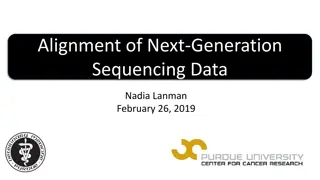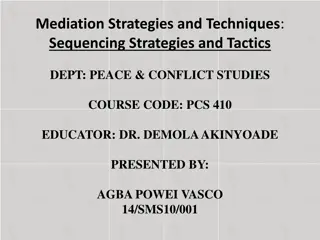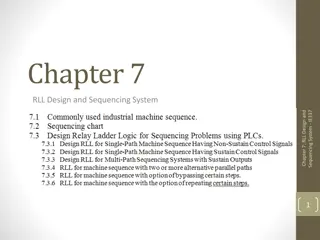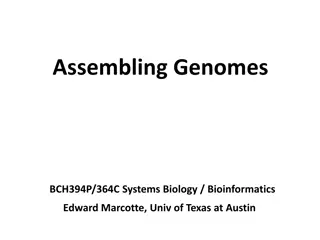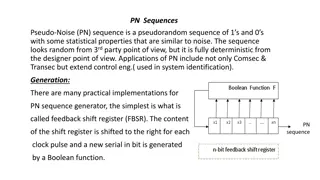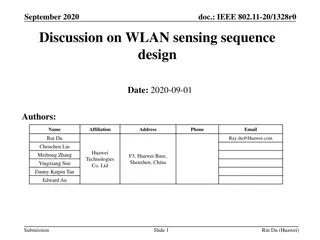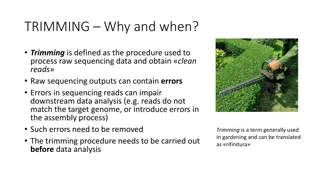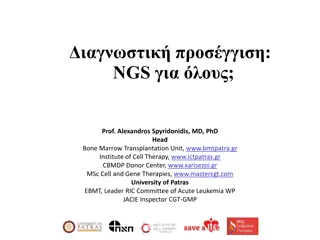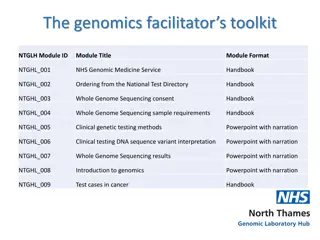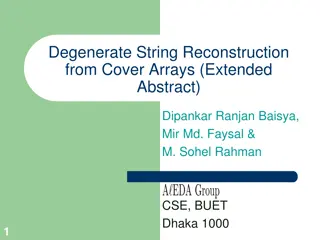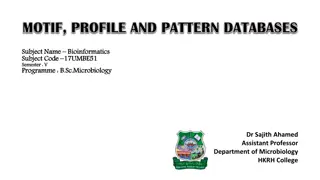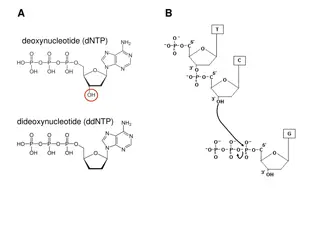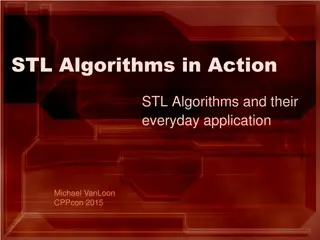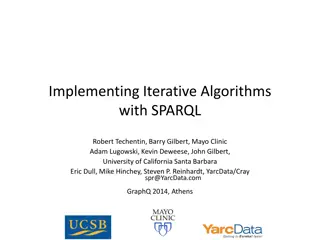Understanding Sequencing Algorithms for Biological Sequences
Karla H. Hermann discusses specific algorithms for sequencing biological sequences, emphasizing the importance of clear experimental questions, good planning, and careful sample handling. Techniques such as RNA sequencing with gel beads and 10x Genomics software are highlighted. The process of picking a cell, amplifying DNA using PCR, and handling variations under unnatural selection are also explained.
Download Presentation

Please find below an Image/Link to download the presentation.
The content on the website is provided AS IS for your information and personal use only. It may not be sold, licensed, or shared on other websites without obtaining consent from the author. Download presentation by click this link. If you encounter any issues during the download, it is possible that the publisher has removed the file from their server.
E N D
Presentation Transcript
THE SINGLES SEEN: SEQUENCING GETS SPECIFIC KARLA H RMANN ALGORITHMS FOR BIOLOGICAL SEQUENCES 2017/12/19
General Reading the Transcript 10x Genomics Software Pick a Cell, any Cell PCR Variation under Unnatural Selection One from Many The Article CONTENT Background Author Publishing
GENERAL Need to know own needs Need clear experimental question Need good planning Need careful sample handling Result: possible to choose right methods no unwanted costs Important to sequence multiple cells before identifying variants! Sandberg (2014)
Add gel beads (containing oligonucleotides/ barcode ) Standard RNA sequencing yields cell RNA and barcode Can reconstruct RNA sequence pool from each cell Divide sample of cell into small droplets Huge amount of data -> need for software READING THE TRANSCRIPT
10X GENOMICS SOFTWARE 10x Genomics(2017)
PICK A CELL, ANY CELL 1st step: how to pick a cell Spread cell over array of magnetic rafts Lift and transfer desired cell with inverted microscope 2nd step: amplifying DNA PCR (Polymerase Chain Reaction) MDA (Multiple Displacement Amplification) 3rd step: construct libraries and sequence them https://www.pinterest.com/pin/332562753707494898/
POLYMERASE CHAIN REACTION (PCR) Garibyan, L., & Avashia, N. (2013)
VARIATION UNDER UNNATURAL SELECTION Normal cell isolation and genome amplification faulty Problem: cell-lysis protocols Solution: new technology avoids heating Reasons to use contractors Expertise Many amplification methods (PCR/ MDA/ MALBAC) https://www.pinterest.com/pin/332562753707494898/
ONE FROM MANY Great advancements in this field Isolating single genomes Amplifying single genomes Lowering costs More standardized methods Holism or reductionism? https://www.pinterest.com/pin/332562753707494898/
AUTHOR Alan Dove I am a science journalist, podcaster, blogger, and editor who lives in western Massachusetts (Doyle, n.d.) Bachelor in Biology (Towson State University, Maryland) Ph. D. in Microbiology (Columbia University, New York) Brian (2013)
http://www.sciencemag.org/features/2017/11/singles-seen-sequencing-gets-specifichttp://www.sciencemag.org/features/2017/11/singles-seen-sequencing-gets-specific PUBLISHING Science/ AAAS Custom Publishing Office https://www.10xgenomics.com/
REFERENCES Brian. (2013, May). Alan Dove, Ph.D. Retrieved on November 15, 2017 from http://thepostdocway.com/spotlight/alan-dove-phd Dove, A. (2017). The singles seen: Sequencing gets specific. Science, 358 (6363),p. 677 679. Retrieved http://www.sciencemag.org/features/2017/11/singles-seen-sequencing-gets-specific from Dove, A. (n.d.). Alan Dove, Ph.D. Retrieved on November 15, 2017 from http://alandove.com/grav/ Garibyan, L., & Avashia, N. (2013). Research Techniques Made Simple: Polymerase Chain Reaction (PCR). The Journal of Investigative Dermatology, 133(3), e6. http://doi.org/10.1038/jid.2013.1 Hu, P., Zhang, W., Xin, H., & Deng, G. (2016). Single Cell Isolation and Analysis. Frontiers in Cell and Developmental Biology, 4 (116). http://doi.org/10.3389/fcell.2016.00116 Pulizzi, J. (2010, December 20). Custom Publishing vs. Content Marketing. Retrieved on November 15, 2017 from http://contentmarketinginstitute.com/2010/12/custom-publishing-content-marketing/ Sandberg, R. (2014) Entering the era of single-cell transcriptomics in biology and medicine. Nature Methods, 11, 22 24. doi:10.1038/nmeth.2764 10xGenomics. (2017). Identifying Cell Types. Retrieved on November 16, 2017 from https://support.10xgenomics.com/single-cell- gene-expression/software/visualization/latest/tutorial-celltypes



